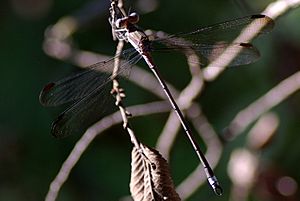Great spreadwing facts for kids
The great spreadwing (Archilestes grandis) is a type of damselfly. It belongs to the Lestidae family. When these damselflies get scared, they often fly back to the same spot they were on, or to another spot very close by.
Quick facts for kids Great spreadwing |
|
|---|---|
 |
|
| Scientific classification | |
| Kingdom: | |
| Phylum: | |
| Class: | |
| Order: | |
| Suborder: | |
| Family: | |
| Genus: |
Archilestes
|
| Species: |
A. grandis
|
| Binomial name | |
| Archilestes grandis (Rambur, 1842)
|
|
Contents
What Great Spreadwings Look Like
The great spreadwing is one of the biggest spreadwings in North America. It can be about 2 to 2.4 inches long. Its wings can spread out to about 3 inches wide.
Male great spreadwings have a dull greenish-bronze upper body. They have a wide yellow stripe that goes across their sides. This is the only spreadwing with such a clear yellow stripe. Their main body part, called the abdomen, is dark with a blue-gray tip. Their eyes and face are blue.
Female great spreadwings look a lot like the males. However, their bodies are more brown. Their eyes are also a lighter blue than the males'. Females also have the yellow stripe on their sides. When females are laying eggs, their color might change to a putty-like shade. This helps them blend in with the withered leaves where they lay their eggs.
Where Great Spreadwings Live
You can find the great spreadwing in western and southern North America. They are more common in the western parts of the United States. You can also find them in Central America and northern South America.
Since the 1920s, the Archilestes grandis has been spreading. It has moved further east and north in North America.
Great Spreadwing Homes
Great spreadwings like places with slow, small streams. These streams often have alder or willow trees nearby. They also like wetlands, ponds, and even temporary pools of water.
They can easily breed in water gardens that have lots of plants and clean water. They also live in natural water areas. Female damselflies lay their eggs in plants like water iris. The male often holds onto the female while she lays the eggs.
Male great spreadwings usually hang from plants that are over or near water. They often stay fairly low, usually under 2 feet from the ground. Sometimes, you can see their young, called nymphs, in winter. They like to warm up in shallow water when the sun is out, often next to tadpoles. You can tell them apart by their Y-shaped tails, which are actually their gills.
When They Are Active
These damselflies are most active from April to December. The exact timing can change depending on how warm the weather is.
Great Spreadwing Life Cycle
When great spreadwings mate, the female collects sperm from the male. After that, she makes a small cut in a plant that is growing out of the water. She then lays her eggs inside this cut.
The young damselflies, called nymphs, grow underwater. When they are ready to become adults, they climb out of the water. Like other damselflies and dragonflies, they usually come out as adults when it's dark.
- 1.Great Spreadwing - Archilestes grandis - BugGuide.Net
- 2.Wisconsin Odonata Survey - Archilestes grandis
- 3.Great Spreadwing - Archilestes grandis
See also
 In Spanish: Archilestes grandis para niños
In Spanish: Archilestes grandis para niños

